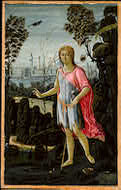
|
Jacopo del Sellaio (artist) Italian, 1441/1442 - 1493 Saint John the Baptist, c. 1480 oil on panel Overall: 52 x 32.8 cm (20 1/2 x 12 15/16 in.) framed: 67.3 x 48.3 x 7.6 cm (26 1/2 x 19 x 3 in.) Samuel H. Kress Collection 1939.1.283 |
Object 4 of 8
Small devotional images such as this were produced in large numbers by craftsmen and lesser-known artists for the homes of Florence's middle class. These artists often filled in at leading workshops when extra assistants were needed for important commissions. We know, for example, that Jacopo worked with Filippo Lippi, Ghirlandaio, and Botticelli.
This painting reflects the concerns of Florentine merchants and their pride in the city. John the Baptist was the patron saint of Florence, and we see him here before the city skyline. Clear in the distant landscape are the Palazzo Vecchio, center of the city administration; Brunelleschi's huge cathedral dome; and the campanile designed by Giotto. (It is one of our earliest painted views of Florence.) Other details preserve a traditional, conservative religious outlook. The bowl at the saint's foot recalls his baptism of Christ, while goldfinches, whose red markings were believed to have been made by Christ's crown of thorns, remind viewers of the Crucifixion. Most telling is the axe sunken into the tree trunk at the left edge of the painting, which refers to Luke 3:9: "every tree therefore which bringeth not forth good fruit is hewn down." This was a pointed warning against the unorthodox beliefs of some of the city's patrician elite, echoing Savonarola's sermons against their dangerously paganlike tendencies.
| « | back to gallery | » | continue tour |


